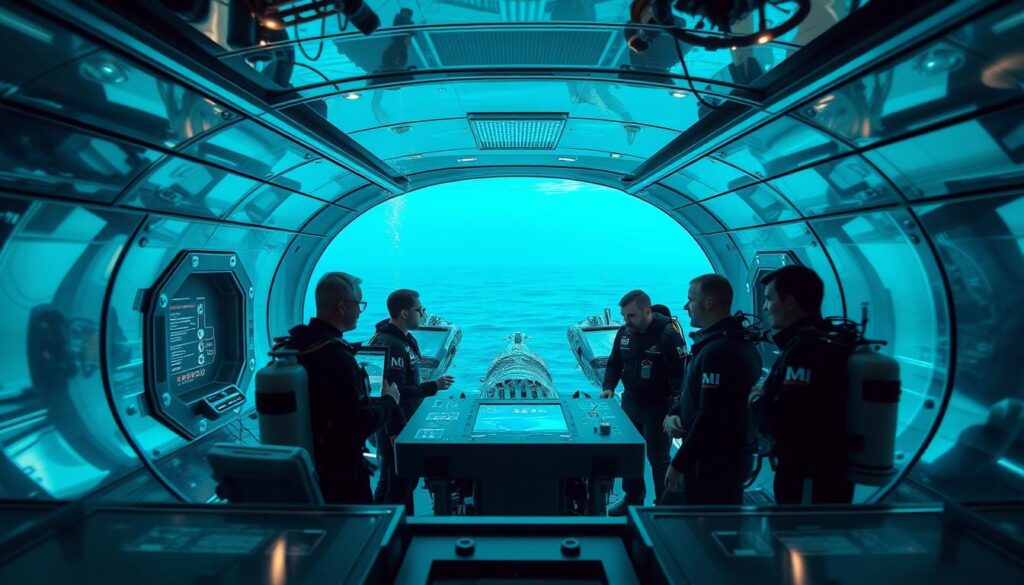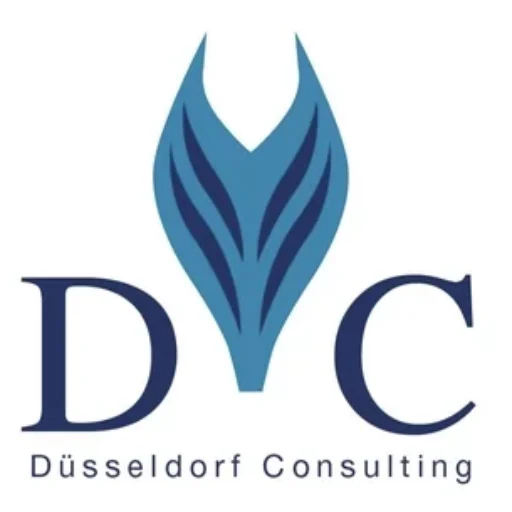Germany is emerging as a hub for innovative underwater imaging technology, driven by advancements in artificial intelligence and machine learning. Startups like Atlantic Tech & Candy and Lolaark Vision Inc. are making significant strides in marine surveying companies by leveraging cutting-edge technologies to improve marine exploration and underwater mapping.
Atlantic Tech & Candy has developed innovative synthetic underwater imagery approaches, while Lolaark Vision Inc. specializes in restoring visibility in live video streams. These advancements are revolutionizing the field, enabling more accurate and efficient underwater mapping.
Key Takeaways
- Germany is becoming a hub for underwater mapping startups.
- Advancements in AI and machine learning are driving innovation.
- Startups like Atlantic Tech & Candy are pioneering synthetic imagery.
- Lolaark Vision Inc. is developing software for challenging underwater environments.
- Underwater imaging technology is improving marine exploration.
- Marine surveying companies are benefiting from these advancements.
Overview of Computer Vision in Underwater Mapping
The application of computer vision in underwater mapping has significantly enhanced our ability to explore and understand marine environments. Computer vision, a field of artificial intelligence, enables computers to interpret and understand visual information from the world, in this case, underwater.
Definition and Importance
Computer vision in underwater mapping refers to the use of algorithms and statistical models to analyze visual data captured underwater. This technology is crucial for artificial intelligence for underwater exploration, allowing for the detailed examination of marine ecosystems and underwater structures.
Lolaark Vision Inc.’s Clarifier solution is an example of how computer vision technology can improve visual clarity in adverse conditions, benefiting industries like maritime and underwater robotics.
Applications in Marine Research
Computer vision has numerous applications in marine research, including the mapping of marine ecosystems, monitoring of water quality, and inspection of underwater infrastructure. Machine learning in ocean mapping has enabled researchers to analyze large datasets more efficiently, leading to new discoveries and a better understanding of ocean dynamics.
- Marine ecosystem mapping
- Water quality monitoring
- Underwater infrastructure inspection
Advancements in Technology
Recent advancements in computer vision technology have significantly improved the accuracy and efficiency of underwater mapping. Technologies like those developed by Lolaark Vision Inc. have been certified by regulatory bodies such as the American Bureau of Shipping, highlighting their reliability and effectiveness.
| Technology | Application | Benefit |
|---|---|---|
| Computer Vision | Underwater Mapping | Enhanced Accuracy |
| Machine Learning | Ocean Mapping | Increased Efficiency |
| Clarifier Solution | Visual Clarity | Improved Decision Making |
Growth of Startups in the German Market
Germany’s tech industry is seeing a boom in startups that utilize computer vision for underwater applications. This surge is driven by advancements in technology, increasing demand from industries like maritime and offshore energy, and the country’s strong research infrastructure.
Key Statistics and Trends
The global autonomous underwater vehicles market is growing rapidly, with Germany emerging as a significant player. Key statistics include:
| Year | Number of Startups | Investment (in million €) |
|---|---|---|
| 2020 | 15 | 20 |
| 2021 | 25 | 35 |
| 2022 | 40 | 50 |
The trend indicates a steady increase in the number of startups and investment in the sector, highlighting the growing importance of underwater mapping and related technologies.
Factors Driving Growth
Several factors are driving the growth of startups in Germany’s underwater research sector. These include:
- Advancements in AI and Robotics: Improvements in AI and robotics are enabling more sophisticated underwater mapping and exploration.
- Increasing Demand: Industries such as oil and gas, maritime, and offshore energy are driving demand for underwater mapping services.
- Research Infrastructure: Germany’s strong research infrastructure and academic institutions are providing a fertile ground for innovation.
Challenges Faced by Startups
Despite the growth, startups in this sector face several challenges, including:
- High Initial Investment: Developing underwater mapping technology requires significant initial investment.
- Regulatory Hurdles: Navigating the regulatory environment for underwater operations can be complex.
- Technological Challenges: Developing reliable and efficient underwater technology poses significant technological challenges.
Addressing these challenges will be crucial for the continued growth and success of startups in Germany’s underwater research sector.
Notable Computer Vision Startups in Germany
In Germany, a new wave of startups is making significant strides in underwater mapping through the use of cutting-edge computer vision technology. These companies are not only innovating in the field but are also contributing to the growth of the autonomous underwater vehicles industry.
Company Profiles
Several startups are leading the charge in underwater mapping and imaging. Companies like Atlantic Tech and Candy and Lolaark Vision Inc. are developing sophisticated software and hardware solutions that are enhancing the capabilities of underwater exploration.
Atlantic Tech, for instance, is known for its advanced underwater mapping software solutions that enable precise and efficient mapping of underwater terrains. Their technology is being adopted by various research institutions and industries, marking a significant step forward in marine research and exploration.
Innovations and Services Offered
The innovations brought forth by these startups are multifaceted. They include:
- Advanced computer vision algorithms for image processing and analysis
- Autonomous underwater vehicles (AUVs) equipped with state-of-the-art sensors and cameras
- Software solutions for real-time underwater mapping and monitoring
These services are not only enhancing the field of marine research but are also opening up new possibilities for industries such as offshore energy and underwater construction.
Market Impact
The impact of these startups on the market is significant. By pushing the boundaries of what is possible with underwater mapping and imaging, they are driving growth in the autonomous underwater vehicles industry. According to industry reports, the adoption of AUVs is expected to increase significantly in the coming years, driven by advancements in computer vision and related technologies.
| Startup | Innovation | Market Impact |
|---|---|---|
| Atlantic Tech | Advanced underwater mapping software | Increasing adoption in marine research |
| Candy and Lolaark Vision Inc. | High-resolution underwater imaging | Enhancing offshore energy exploration |
“The integration of computer vision in underwater mapping is revolutionizing our ability to explore and understand marine ecosystems.”
As these startups continue to innovate and expand their offerings, the future of underwater mapping and the broader field of marine research look increasingly promising.
Technology Utilized by Startups
Startups in Germany are employing innovative technologies to enhance the accuracy and efficiency of underwater mapping operations. These technologies are pivotal in advancing the field of computer vision-based underwater mapping.
Machine Learning Algorithms
Machine learning algorithms play a crucial role in improving the quality and accuracy of underwater mapping. Companies like Lolaark Vision Inc. are utilizing advanced algorithms to restore visibility in live video streams, thereby enhancing the effectiveness of underwater operations. Machine learning in ocean mapping is revolutionizing the way data is analyzed and interpreted.
- Enhanced image processing capabilities
- Improved object detection and recognition
- Real-time data analysis and decision-making
Data Acquisition Techniques
Advanced data acquisition techniques are being employed by German startups to gather high-quality data for underwater mapping. These techniques include the use of sonar technology, underwater drones, and other specialized equipment to collect detailed data on underwater environments.

Integration with Robotics
The integration of computer vision technologies with robotics is a significant trend among German startups. Companies like Darkhive are developing AI-powered drones for reconnaissance and other underwater applications, showcasing the potential of underwater robotics innovation in enhancing operational efficiency and reducing costs.
- Increased autonomy in underwater operations
- Enhanced precision and accuracy in data collection
- Reduced operational costs and environmental impact
Case Studies: Successful Implementations
German startups are at the forefront of utilizing underwater imaging technology for various marine applications. The success of these technologies is evident in several case studies that highlight their potential.
Marine Ecosystem Mapping
One of the significant applications of underwater mapping is in marine ecosystem mapping. For instance, Atlantic Tech & Candy’s synthetic imagery approach has been used for detecting marine growth on ship hulls, showcasing its potential in understanding and mapping marine ecosystems.
The use of advanced computer vision algorithms allows for the detailed analysis of marine habitats, enabling researchers to monitor changes and understand the health of these ecosystems.
“The integration of underwater imaging technology with machine learning has revolutionized the field of marine biology, allowing for more accurate and efficient data collection.”
Underwater Infrastructure Inspection
Underwater infrastructure inspection is another critical application of underwater mapping technologies. Marine surveying companies are leveraging these technologies to inspect and maintain underwater structures such as pipelines and offshore platforms.
| Technology | Application | Benefit |
|---|---|---|
| Underwater Imaging | Infrastructure Inspection | Enhanced Safety |
| Computer Vision | Ecosystem Mapping | Detailed Analysis |
The use of underwater imaging technology in infrastructure inspection not only improves safety but also reduces costs by minimizing the need for human divers.
Collaboration with Research Institutions
The synergy between German startups and research institutions is pivotal in driving innovation in underwater mapping. This collaboration is essential for advancing technologies and methodologies in the field.
Partnerships with Universities
Many German tech startups in underwater research have formed significant partnerships with universities. For instance, a startup like Lolaark Vision Inc., although based in the US, illustrates the importance of academic collaboration as it was founded by mathematicians from the University of Houston. Similarly, in Germany, startups are leveraging university research to develop cutting-edge underwater mapping technologies.
These partnerships enable startups to access advanced research facilities, talent, and knowledge, thereby accelerating their innovation processes. In return, universities benefit from the practical application of their research, creating a mutually beneficial relationship.
Joint Research Initiatives
Joint research initiatives between startups and research institutions are crucial for tackling complex challenges in underwater exploration. These initiatives often focus on developing new technologies or improving existing ones, such as enhancing artificial intelligence for underwater exploration.
Some of the key areas of focus for these joint initiatives include:
- Improving data acquisition techniques
- Developing more sophisticated machine learning algorithms
- Integrating underwater mapping technologies with robotics
| Research Institution | Startup Partner | Project Focus |
|---|---|---|
| University of Hamburg | HydroTech GmbH | Advanced sonar technologies |
| Technical University of Berlin | Underwater Mapping Solutions | AI-driven underwater inspection |
| University of Kiel | OceanTech Solutions | Marine ecosystem mapping |
The collaboration between German startups and research institutions is a driving force behind the advancements in underwater mapping. By continuing to foster these partnerships, the industry can expect significant breakthroughs in the coming years.
Regulatory Environment for Startups
Underwater mapping startups in Germany must navigate a multifaceted regulatory environment that is evolving to address the unique challenges posed by underwater technologies.
German Regulatory Framework
The German government has established a regulatory framework that balances the need for innovation with safety and environmental concerns. This framework includes regulations specific to the deployment of autonomous underwater vehicles and the development of underwater mapping software solutions.
Key aspects of this framework include:
- Environmental impact assessments for underwater projects
- Safety standards for the operation of underwater vehicles
- Data protection regulations for underwater mapping data
Compliance Challenges
Despite the clarity provided by the regulatory framework, startups face several compliance challenges. These include the complexity of regulations, the need for specialized legal expertise, and the costs associated with ensuring compliance.
A summary of the main compliance challenges is provided in the following table:
| Challenge | Description | Impact on Startups |
|---|---|---|
| Regulatory Complexity | Difficulty in understanding and interpreting regulations | Potential for non-compliance, legal issues |
| Legal Expertise | Need for specialized lawyers familiar with underwater technology regulations | Increased legal costs |
| Compliance Costs | Costs associated with implementing compliance measures | Financial burden on startups |
Addressing these challenges will be crucial for the success of underwater mapping startups in Germany.
Funding Landscape for Startups
Access to funding is a critical factor for the success of startups in Germany’s underwater research industry. The landscape is characterized by a variety of funding sources and evolving investment trends.
Sources of Funding
Startups in the underwater mapping and robotics sector are leveraging multiple sources of funding to drive their innovation and growth. These include:
- Crowdfunding: Platforms that allow startups to raise funds from a large number of people, typically through online campaigns. Lolaark Vision Inc. is an example of a startup that has successfully utilized crowdfunding.
- Venture Capital: Investment firms that provide significant funding to startups with high growth potential. Companies like Helsing have received substantial venture capital investment, enabling them to scale their operations and develop cutting-edge technologies.
- Government Grants and Subsidies: Government programs designed to support innovation and technological advancement. These can be particularly beneficial for startups in the underwater research sector, offering non-dilutive funding.

Investment Trends
The investment landscape for German tech startups in underwater research is witnessing several trends:
- Increasing Interest in Underwater Robotics: Investors are showing a growing interest in startups that are developing innovative underwater robotics solutions.
- Focus on Sustainability: There’s a notable trend towards investing in startups that contribute to sustainable practices and environmental conservation through their technologies.
- Collaborative Funding Models: There’s an emergence of collaborative funding models where multiple investors come together to support promising startups, sharing the risk and reward.
These trends indicate a vibrant and supportive funding ecosystem for startups in Germany’s underwater research sector, facilitating their growth and innovation.
Future Prospects of Underwater Mapping
Underwater mapping is on the cusp of a revolution, thanks to advancements in computer vision and machine learning. The integration of these technologies is enhancing the accuracy and efficiency of underwater mapping, opening up new possibilities for various industries.
Emerging Technologies
Several emerging technologies are set to transform the underwater mapping landscape. Autonomous Underwater Vehicles (AUVs) are becoming increasingly sophisticated, allowing for more detailed and extensive mapping operations. The use of AUVs is expected to grow, driven by their ability to operate in challenging environments without human intervention.
Machine learning algorithms are also playing a crucial role in enhancing underwater mapping. These algorithms can process vast amounts of data, identifying patterns and features that may not be apparent to human analysts. This capability is particularly valuable in applications such as marine ecosystem monitoring and underwater infrastructure inspection.
Predictions for Market Growth
The global market for autonomous underwater vehicles is expected to grow significantly, driven by increasing demand from industries such as maritime, oil and gas, and environmental monitoring. According to market trends, the adoption of AUVs is likely to continue rising, driven by their versatility and the growing need for detailed underwater mapping.
| Industry | Projected Growth Rate | Key Applications |
|---|---|---|
| Maritime | 10% | Navigation, seabed mapping |
| Oil and Gas | 8% | Pipeline inspection, offshore exploration |
| Environmental Monitoring | 12% | Ecosystem monitoring, conservation efforts |
The future of underwater mapping looks promising, with emerging technologies and growing demand from various industries set to drive market growth. As these technologies continue to evolve, we can expect to see significant advancements in the field.
Environmental Impact of Underwater Mapping
Artificial intelligence for underwater exploration is enhancing our ability to monitor marine biodiversity. Underwater mapping technologies are being increasingly utilized to support conservation efforts and protect marine ecosystems. This section explores the significant environmental implications of these technologies.
Contribution to Conservation
Underwater mapping plays a crucial role in conservation by providing detailed insights into marine ecosystems. Marine surveying companies are using these technologies to map habitats, track changes, and identify areas that require protection. For instance, high-resolution maps of seafloor topography can help in understanding the health of coral reefs and the impact of climate change.
The data collected through underwater mapping can inform conservation strategies and policy decisions. As noted by a marine biologist, “Accurate underwater maps are essential for effective marine conservation, allowing us to monitor changes and respond to threats proactively.”
“The use of advanced underwater mapping techniques has revolutionized our ability to protect and preserve marine ecosystems.”
Monitoring Marine Biodiversity
Underwater mapping is also vital for monitoring marine biodiversity. By creating detailed maps of marine habitats, researchers can identify areas of high biodiversity and track changes over time. This information is critical for developing effective conservation plans.
| Application | Benefit |
|---|---|
| Habitat Mapping | Identifies areas of high biodiversity |
| Change Detection | Tracks the impact of climate change and human activities |
| Conservation Planning | Informs the development of effective conservation strategies |
The integration of artificial intelligence and machine learning algorithms with underwater mapping technologies is further enhancing our ability to monitor and protect marine ecosystems. As these technologies continue to evolve, we can expect even more sophisticated tools for environmental conservation.
Community Engagement and Awareness
German tech startups in underwater research are increasingly focusing on community engagement and public education. This shift towards raising awareness about the importance of underwater mapping is crucial for the successful adoption of these technologies.
Educating the Public
Public education initiatives are being implemented to inform people about the applications and benefits of underwater mapping. These initiatives include workshops, seminars, and online resources that explain the technology and its uses in marine research.
For instance, some startups are collaborating with educational institutions to develop curricula that incorporate underwater mapping and its applications. This not only educates the next generation but also fosters interest in STEM fields.
Involving Local Communities
Involving local communities in underwater mapping projects is vital for their success. Startups are engaging with local populations through various initiatives, such as citizen science projects, where community members can participate in data collection and research.
This involvement not only aids in the collection of valuable data but also helps in raising awareness about the importance of marine conservation. Local communities are more likely to support initiatives that they are involved in.
The impact of community engagement can be seen in the increased support for underwater mapping projects. As the public becomes more informed, there is greater acceptance and enthusiasm for these technologies.
| Initiative | Description | Impact |
|---|---|---|
| Workshops and Seminars | Educational events for the public | Increased awareness and understanding |
| Citizen Science Projects | Involvement of local communities in data collection | Valuable data and community engagement |
| Curriculum Development | Incorporation of underwater mapping in educational curricula | Education of future generations |
Conclusion
Computer vision-based underwater mapping startups in Germany are driving innovation in the underwater robotics innovation sector, with significant economic and environmental implications. The growth of these startups is transforming the autonomous underwater vehicles industry, enabling more efficient and accurate mapping of marine ecosystems.
Economic and Environmental Significance
The economic importance of underwater mapping lies in its potential to support offshore construction, environmental monitoring, and marine conservation. By leveraging advancements in computer vision and machine learning, these startups are creating new opportunities for sustainable development and reducing the environmental impact of human activities on marine ecosystems.
Future Directions
As the autonomous underwater vehicles industry continues to evolve, German startups are poised to play a key role in shaping the future of underwater exploration and mapping. Future directions for these startups include the development of more sophisticated underwater robotics innovation and the integration of artificial intelligence with underwater vehicles.
FAQ
What is computer vision-based underwater mapping?
Computer vision-based underwater mapping is a technology that uses computer vision techniques to analyze and interpret visual data from underwater environments, creating detailed maps of the seafloor.
How are German startups contributing to underwater mapping?
German startups are leveraging advancements in artificial intelligence, machine learning, and robotics to improve underwater mapping, developing innovative software and hardware solutions for marine exploration and research.
What are some applications of underwater mapping?
Underwater mapping has various applications, including marine ecosystem mapping, underwater infrastructure inspection, environmental monitoring, and offshore energy exploration.
What technologies are being used by startups for underwater mapping?
Startups are utilizing machine learning algorithms, advanced data acquisition techniques, and integration with robotics, such as autonomous underwater vehicles, to enhance the accuracy and efficiency of underwater mapping.
How are research institutions collaborating with startups in underwater mapping?
Research institutions are partnering with startups to drive innovation, through joint research initiatives, development of new technologies, and knowledge sharing, accelerating the growth of the underwater mapping sector.
What are the regulatory challenges faced by startups in underwater mapping?
Startups in underwater mapping must comply with German regulations, such as those related to environmental protection, data privacy, and maritime law, which can be complex and challenging to navigate.
What is the future outlook for the underwater mapping market?
The underwater mapping market is expected to grow, driven by emerging technologies, increasing demand from industries such as maritime, oil and gas, and environmental monitoring, and advancements in AI and robotics.
How is underwater mapping contributing to environmental conservation?
Underwater mapping is being used to support environmental conservation, by monitoring marine biodiversity, tracking changes in ocean health, and informing conservation efforts, ultimately contributing to the protection of marine ecosystems.
What role does community engagement play in the adoption of underwater mapping technologies?
Community engagement and public awareness are essential for the successful adoption of underwater mapping technologies, through initiatives aimed at educating the public about the importance and applications of these technologies.
What are the main sources of funding for underwater mapping startups in Germany?
Underwater mapping startups in Germany are accessing funding from various sources, including venture capital, government grants, and private investors, to drive innovation and growth.



